View picture gallery
Phew, this heat! In Austria and Germany people often whine when it gets really hot. No wonder: Such heat is the exception. In other countries and cities, people have more routine with it. How do people who are more experienced in heat deal with extreme temperatures in hot metropolises?
Bangkok: In Thailand’s capital, people are used to the heat, and there is no such thing as a “cool season”. That’s why many Thais don’t undress, but cover themselves up – and wear long sleeves, hats and umbrellas. This protects against heat and sun, but also against an unwanted tan: skin that is as white as possible is considered the ideal of beauty in Thailand. If you live in Bangkok, you will quickly get up early because of the extreme heat. The markets are already full shortly after sunrise, and Zumba or yoga is practiced in the parks. But nothing is better suited for refreshment than the cool shopping malls. For many, “Siam Paragon”, “Terminal 21” or “EmQuartier” act as a second home at the weekend, because they offer everything from fashion to massages and fitness to gourmet temples and cinemas.
Gigantic park and underground cooling
Singapore: Temperatures in the ultra-modern, but also ultra-hot city-state are rising twice as fast as in the rest of the world. The government-sponsored “Cooling Singapore” project is developing strategies to lower temperatures and keep people cool – without polluting the environment too much. A flagship project is the award-winning Park Gardens by the Bay. In gigantic greenhouses, which invite you to stroll and linger, the values are a pleasant 24 degrees. Responsible is what is probably the largest underground district cooling system in the world, which also supplies two dozen residential towers and other buildings in the vicinity. The system uses chilled water – an electricity saving of 40 percent compared to conventional air conditioning systems. In addition, Singapore, also known as the “garden city”, relies on vegetation for cooling: countless trees and plants provide shade and ensure better air quality.
The principle of evaporation
New Delhi: In India, when it’s hot, you can often see children playing in ponds or fountains in parks. Doors and windows of houses are then often covered with mats of grass or straw and wet several times a day. This also brings in a slightly cooler wind. Many people also use simple evaporative coolers (desert coolers) in their homes. There is water in these machines, and when you connect them to electricity, they draw in warm air from around them and cool it with the water. The principle: where water evaporates, heat is extracted. Basically, people in South Asia wear long and thin clothes that cover their arms and legs when it is hot. Some people also carry umbrellas. During the hottest part of the day, many who can afford to stay at home. In addition, people drink a lot – water is offered everywhere when it is hot, or you drink shikanji, a lemon juice with sugar, salt and water, which helps against dehydration.
Intelligent architecture provides shade
Doha: For residents of the Gulf States and the Arab world, heat is part of everyday life. The people in the region are quite used to 40 degrees. In Qatar, the host country of the 2022 World Cup, the hip Muschairib district of the capital Doha is a good example of how smart urban planning can help cope with the summer heat. The modern buildings in the traditional style are laid out in such a way that pedestrians can walk in the shade throughout the district. To do this, the architects designed the area in such a way that air currents between the houses ensure a breeze. The region is known for its hospitality, which is also reflected in the city architecture. In the past, homeowners often built one floor higher to provide shade for their neighbors, locals in Qatar say. Today, residents of the region mostly spend the hottest part of the day at home with air conditioning. Only when it gets cooler and temperatures drop to a good 30 degrees do people flock outside in the evening hours. Popular in many countries in the Arab world are mobile outdoor air conditioners, which are set up next to the tables in restaurants and cafes and provide cool air – the equivalent of patio heaters, so to speak.
Numerous drinking water dispensers on the beach
Tel Aviv: Temperatures between 30 and 40 degrees in summer are not uncommon in the Israeli coastal city of Tel Aviv. The good thing about the city on the Mediterranean: There is plenty of water. There are also drinking water dispensers distributed throughout the city at regular intervals – not only on the kilometer-long beach promenade, but also in many other places: fill up the water bottle and you’re done. This not only protects against sunstroke, but also saves money in one of the most expensive cities in the world. In general, outdoor life tends to shift into the evening. After sunset, bars and restaurants fill up and Tel Avivians leave their severely chilled homes and offices. In order not to arrive at work too sweaty during the day, many people ride e-bikes.
The night becomes day
Athens: In the Greek capital, people vote on the heat with their feet. By the beginning of August at the latest, the majority of the approximately three million inhabitants make a pilgrimage to the sea, to villages and to islands, preferably where they have relatives. Result: The otherwise so noisy metropolis falls into a kind of summer sleep. There is hardly any traffic, even the small kiosks, which are otherwise often open around the clock, remain closed. An exception is the city center including the old town around the Acropolis. However, there are hardly any Greeks there, but tourists. When it’s hot, Athenians only leave their homes in the morning or after sunset, if at all. That’s why in Greece people don’t eat until late in the evening in summer, and children romp around in playgrounds until after midnight.
cooling floor
Rome: If you need to cool down here, for example, you can look for one of the many gray fountains from which drinking water flows – also called nasone because of the nose-like shape of the tap. In Italian cities, people fill up their bottles there, cool their faces or let their dogs drink. Milan tried to create an example of more plants and a better microclimate in the city with a vertical greening project on two skyscrapers. Many apartments and houses in Italy have a stone or tiled floor that is supposed to keep them cool. Fruits are also popular, especially watermelons, which serve as a refreshing snack in hot weather. Cool meeting places, especially in residential areas, are also churches, for example. Those who can afford it in Italy escape the summer heat in the city and go to the second home in the mountains or by the sea, where the climate is a little cooler. Many popes also travel year after year from the Vatican to Castel Gandolfo, not far from Rome – the papal summer residence. However, Pope Francis has so far refrained from doing so.
Siesta and soups
Madrid: In the Spanish capital, around 40 degrees are quite normal in summer. The Madrileños are used to the heat and know how to cope with it – and even enjoy it. Unlike in Austria, for example, there are air conditioners almost everywhere: in shopping centers as well as in shops, restaurants or cafés, in the subway, on the bus, in offices and especially at home. Most Spaniards don’t only wear light, light clothing in Madrid in the summer. Eating habits are also adapted to the climate: in summer people like to refresh themselves with cold soups such as gazpacho or salmorejo. Thanks to the ubiquitous water mist cooling systems, the long evenings can also be spent in the outdoor areas of bars and restaurants with a Rioja or a Cerveza. When the sun is particularly hot – between 2:00 p.m. and 6:00 p.m. – people withdraw. The siesta, the “midday nap”, is as much a part of Spain as paella. Offices then take longer breaks, and “Closed” signs are hung outside in most shops. During the siesta, however, very few Spaniards still take a nap like they used to. You go to the gym or the swimming pool or have longer lunches with family or colleagues.
Midnight sports on Copacabana
Rio de Janeiro: When the temperatures rise to what feels like 50 degrees in the Brazilian summer, you get the feeling of melting. Air conditioners are the most important pieces of furniture to keep a cool head in the metropolis. The days are getting longer, sporting activities are shifting to the early morning or the night. “Cariocas”, as the inhabitants of Rio are called, still play volleyball or futevolei at midnight, for example on Copacabana beach. January in Brazil and other South American countries is like August in Austria. Many crowd Rio’s famous beaches and take sea baths to cool off. Others prefer to travel during the tropical, hot summer months or, like Stefan Zweig, retreat to Petrópolis in the mountainous region of Rio, where the climate is cooler due to the altitude.
Fire brigade opens hydrants
New York: When it gets really hot in NYC’s urban jungle – and it gets hot every summer – residents know a tried and tested remedy: fire hydrants. The fire brigade opens – according to an official request – a hydrant per street block, which then spits out water. With less pressure than for fire fighting, but enough to keep children, adults and thirsty birds and pets happy and cool for hours.
Asphalt is painted bright
Los Angeles: In west Los Angeles, the sea breeze from the Pacific cools, but in many parts of the Californian metropolis the heat often rises to over 35 degrees Celsius (95 degrees Fahrenheit). The “Cool Streets LA” program aims to reduce extreme temperatures by at least a few degrees. The trick: black asphalt is painted over with a light colour. The project, which has been running since 2019, is whitewashing hundreds of street blocks in the hottest districts with a white coating that reflects sunlight more and absorbs less heat.
Palm Springs: When it comes to heat, the desert city with its palm trees and mid-century architecture puts everything else in Southern California to shame. Heat-stressed people without their own air conditioning can seek refuge in “Cooling Centers” until the end of September. As soon as it is more than 38 degrees Celsius, the city invites you to three air-conditioned cooling centers. One of them is the local library.
Source: Nachrichten




